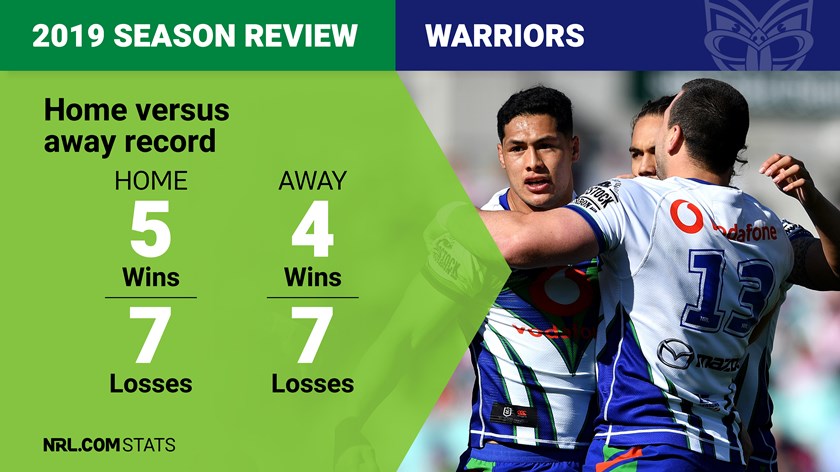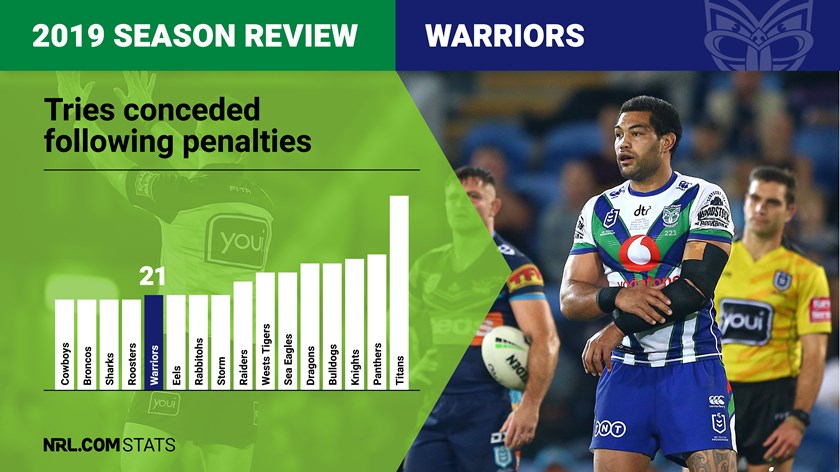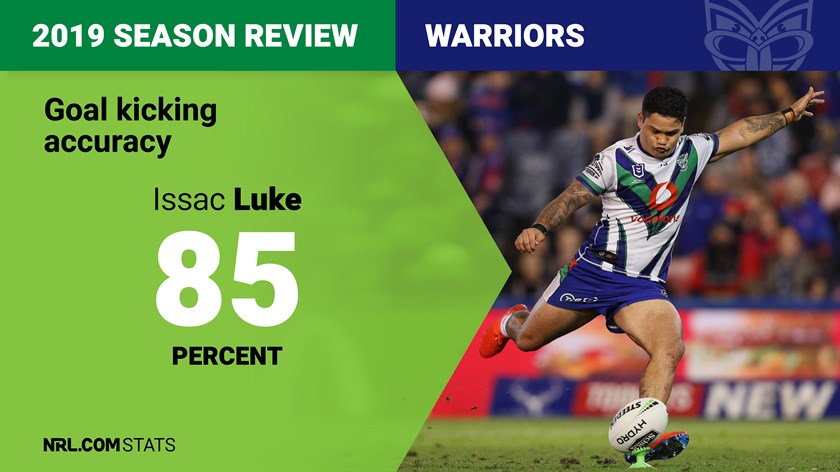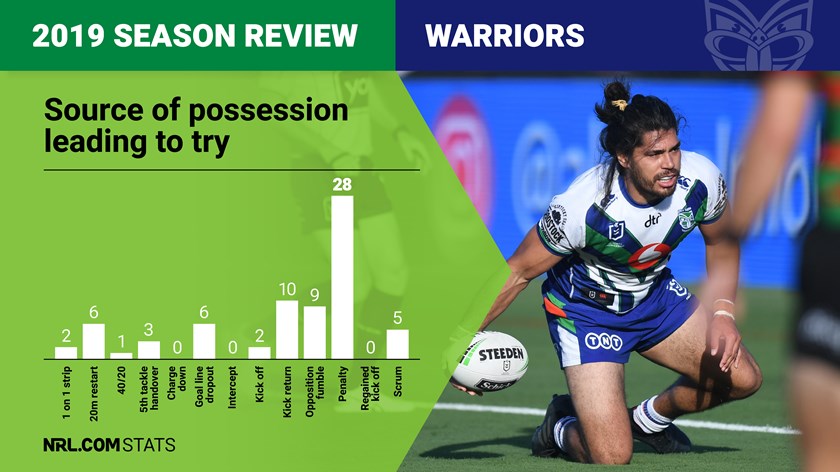It looks like you may be using adblocking software to view this site.
Many features on the site, such as video playback, may not work properly when using adblocking software.
Please whitelist our domain or disable your adblocker to access all features and videos.
The 2019 season has to be regarded as a disappointment for the Auckland-based club, having made the finals a year earlier only to lose far too many home games to give themselves a real chance of making a dent in the 2019 Telstra Premiership.
With star playmaker Shaun Johnson departing late in the pre-season and former Bronco Kodi Nikorima only arriving mid-season, a revolving door of halves partners for Blake Green and further injury woes at dummy-half meant the playmaking set-up struggled to ever really find its feet.
There were some green shoots in the form of players like Chanel Harris-Tavita and Jazz Tevaga while others like Roger Tuivasa-Sheck and Ken Maumalo were too-rare islands of consistency. NRL.com Stats has run the rule over where the Warriors fell short in 2019.
New Zealand Warriors: 2019 season by the numbers
Home & Away record

While the Warriors have always had to face a hefty travel burden, the fact the 15 Australia-based NRL clubs have to cross the Tasman for Warriors home games should present some sort of advantage at home but that has not been the case over the past two seasons. Even when the Warriors made the finals in 2018 their away record was better than their middling home form. After winning their first two home games the Warriors lost their next six at Mt Smart to give themselves almost no chance of featuring in the finals.
Post-contact metres
Post-contact metres – additional ground gained by a ball carrier after meeting the defence – are a precious commodity early in yardage set when every metre gained is like gold. On the flipside they are arguably counter-productive when your team is inside the attacking 40 and fast play-the-balls and ball movement is the order of the day. With that in mind, this is an area where the Warriors had some impact, with two of their back three making the top 10 right across the NRL. In a list headed by Broncos prop Payne Haas (72 metres per game), Warriors winger Ken Maumalo (65 metres per game) and fullback Roger Tuivasa-Sheck (55m PG) were consistently able to get yardage sets rolling early. On a per-carry basis, Maumalo (3.3, per run) was bettered by impact forwards Bunty Afoa (3.7m PR), Leeson Ah Mau and Ligi Sao (both 3.5m) with Afoa just scraping into the NRL top 10.

Tries scored by channel
Easily the Warriors' most prolific route came on the far left flank, as Dally M winger of the year and the competition's third-top try-scorer Ken Maumalo racked up 17 four pointers playing outside Peta Hiku with the club crossing for 25 in total on the far left. Overall 42% of Warriors tries came on the left edge or centre-left channel compared to 31% on the right side. Only the Storm and Roosters scored more tries on the left wing, whereas the club doesn't figure in the top half of teams in any of the other four scoring channels.

Tries conceded by channel
The Warriors leaked more points on the right than the left, with 44% of their 95 tries conceded in 2019 coming through the right or centre-right channels. Their 33 total tries through the centre-right channel was not just the worst in the NRL for that channel, but the worst in the NRL for any channel, ahead of the 28 leaked by Gold Coast through the centre-left. They were also worryingly flimsy through the middle, with 19 tries up the middle the fourth-worst tally in the NRL.

Tries conceded from penalties
The Warriors may have had some defensive frailties in 2019 but they were among the best in the comp at defending penalties. Pinged 156 times through the season, the Warriors conceded just 21 tries from those infringements – only one more than the competition's fewest (the Cowboys, Broncos and Sharks all conceded 20 tries in the set after a penalty). With 21 of 95 tries conceded in the set after a penalty, the Warriors' tally of 22% of tries conceded coming from a penalty was the lowest in the NRL.

Metres gained from offloads
Offloads can be a double-edged sword, providing the unpredictable second-phase footy that can help break down the NRL's most efficient defensive structures while also hugely increasing the risk of losing possession. More offloads rarely equals more wins in simple black and white terms, with the Bunnies, Roosters and Storm throwing the fewest in 2019, while fifth-placed Parramatta threw the most. But it's a style that usually seems to gel well with the Warriors and their foray into no-offload no-risk footy in 2017 did not pay any dividends. In saying that the Warriors threw the fourth-most in 2019 with 286 total. Agnatius Paasi (37, 10th most in NRL) was the main contributor with 311 metres added from his offloads. Adam Blair and Tuivasa-Sheck's offloads each added more than 200 metres through the season.

Goal-kicking accuracy
The Warriors had a few issues in 2019 that need improvement but work off the tee wasn't really one; their 81% success rate, predominantly via Adam Keighran, Chanel Harris-Tavita, Patrick Herbert and Issac Luke, was the fifth-best in the NRL. Keighran (90%) and Luke (85%) were among the NRL's best in their limited stints.

Try-scoring source of possession
While the Warriors were good at not getting scored on after conceding a penalty, they were also excellent at taking advantage when the shoe was on the other foot. The Warriors scored 28 tries in the set after receiving a penalty in 2019; the only teams that did so more often finished in the top four. Conversely they were the equal-worst side – level with Gold Coast – at scoring in the set after feeding a scrum with just five such tries all year.

Tries conceded from kicks
The Warriors conceded 23 tries from kicks in 2019 – the fourth most of any club. Perhaps tellingly, this stat appears to be well-correlated with team success given the four teams with the fewest tries conceded from kicks finished in the top four. The most failed defusals came from fullback Tuivasa-Sheck but to be fair he had far and away the most kicks sent his way, finishing with 86 out of 103 (17 failed) for 83% success, but it was still the second-most missed defusals across the NRL behind only Brisbane's Jamayne Isaako (22). Maumalo's rate was a bit lower at 79% from his 47 attempts and Fusitu'a a touch lower again at 76% from 21. Kodi Nikorima (five), Hiku, Solomone Kata and Gerard Beale (all four) missed a few from a smaller number of attempts.

Metres gained per set
The Warriors were among the best at trucking it out of their end, with the likes of Tuivasa-Sheck and Maumalo making big metres on early plays and rugged ball-runners in the forwards like Ah Mau, Paasi and Afoa keeping the momentum going. All up the Warriors averaged 43.9 metres gained per set, fractionally trailing just premiers the Roosters (44.0 metres per set) with half the competition averaging below 42 metres per set. It may not sound like a big deal but with between 30 and 40 sets for each team per game, a two-metre advantage per set equates to virtually one free trip the length of the field.









